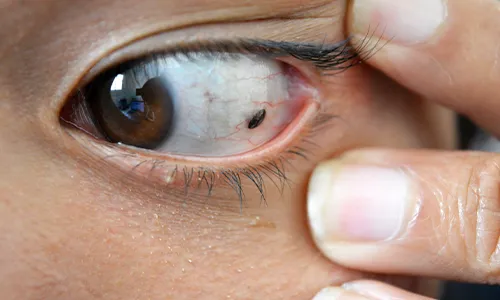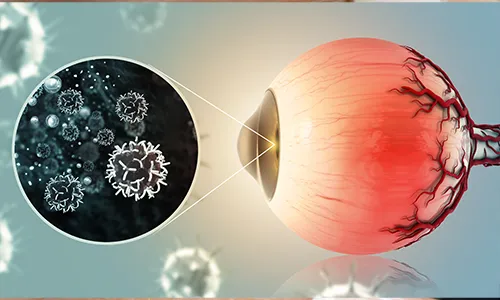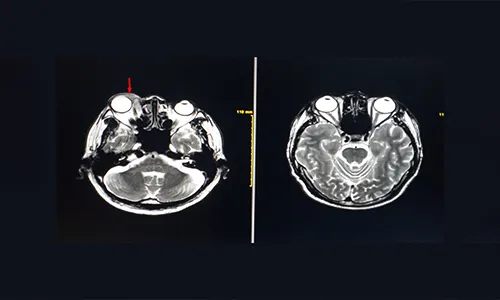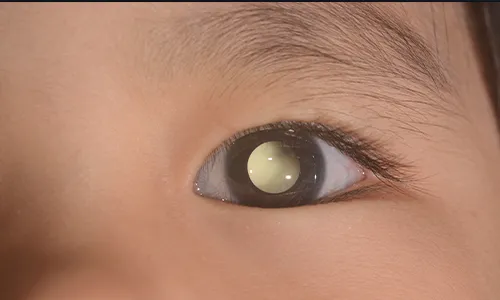


About Eye Cancer
Eye cancer is the term used to describe any cancer that starts in the eye. Healthy cells in or near the eye undergo a change that causes them to proliferate out of control, resulting in a mass known as a tumor. Other malignancies, however, affect other eye cell types.


Risk Factors & Prevention
Eye melanoma can develop at any age, but as people age, their risk increases. Men are slightly more likely than women to have eye melanoma.
Some risk factors are:
- Eyes with a light color
- Several hereditary disorders, such as BAP1 cancer syndrome and dysplastic nevus syndrome
- Moles
- Overexposure to sunlight
- Skin melanoma
- Some professions, such as welders
How it can be prevented?
- Restricting time spent in the sun
- Donning protective clothing and headgear
- Applying sunscreen
Putting on wraparound sunglasses with 99 to 100 percent UVA and UVB absorption to protect the eyes and the skin surrounding them.


Screening
There are no generally accepted screening procedures for those at average risk for eye cancer because it is a rare malignancy. However, certain eye tumours are detectable early by regular eye exams.


Symptoms & Signs
- Difficulties with eyesight (Blurry or an abrupt loss of vision)
- Floaters (specks or squiggles floating in the field of view)
- Visually partially impaired (losing a portion of your visual field)
- A developing dark patch on the eye’s coloured area (iris)
- When the pupil’s size or shape is changing (the smudge or a dark spot in the middle of the eye)
- The eyeball’s location inside its socket shifts
- The eye bulges
- Observing light-flashes


Diagnosis
Eye cancer diagnostic tests determine whether you have the disease and how aggressive it may be.
Tools and tests include:
- Fundoscopic Eye examination
- Ultrasound
- Fluorescein angiography
- Fine needle biopsy
- MRI orbit
- PET-CT scan


Sub-Types and Stages
A. Intraocular cancers
a. Primary intraocular cancers
- Retinoblastoma
- Medulloepithelioma
b. Secondary intraocular cancers
- Intraocular melanoma
- Uveal melanomas
- Conjunctival melanomas
- Lymphomas
B. Orbital and adnexal cancers
Stages
The staging depends on the type of eye tumor. It has three
components:
T: Tumor size
N: No. of lymph nodes involved
M: Spread to other organs / metastasis


Treatment Modalities
a. Surgical Oncology
The following surgical options:
- Iridectomy- Partial iris removal.
- Iridocyclectomy- Removing a portion of the iris and ciliary body.
- Sclerouvectomy / endoresection- The procedure that removes the choroidal tumor.
- Enucleation- Eye removal surgery.
b. Medical Oncology
- Chemotherapy- Chemotherapy kills cancer cells by using chemicals. One chemotherapy medicine may be administered, or two or more drugs may be combined.
- Immunotherapy- A medicinal therapy called immunotherapy supports the immune system’s ability to fight cancer. If the cancer is advanced and other treatments have failed, immunotherapy may be tried.
c. Laser therapy
- When surgery or radiation is not an option, laser therapy may be used to treat eye melanoma.
- The most popular laser therapy for eye melanoma is transpupillary thermotherapy (TTT). Others are Photodynamic therapy and laser photocoagulation.
d. Radiation Oncology
- Radiation therapy reduces the risk of losing the eye’s vision. Brachytherapy (Plaque therapy) and external beam radiation therapy are two different types of radiation therapy that can be used to treat eye malignancies.



Coping with Treatment
Along with the medical side effects of eye cancer therapy, patients also deal with the financial burden of cancer care and the emotional and social impacts. Talking to a counselor, or family member can help them to cope with treatment. MOC provides facility of psycho Onco-Counseling and Nutritional counseling to help patients.


Do’s & Don’ts During Treatment
Do’s
- Maintain proper hygiene
- Protect the eye
Don’ts
- Avoid engaging in any strenuous activities
- Avoid gardening
- Avoid contact with pet hair


Post-Treatment Support
Post-treatment eye cancer survivors can go through long-term side effects of surgery, radiation therapy, chemotherapy. One of their primary worries with laser therapy is the possibility of eye damage, which could lead to blindness. Survivors require empathy, mental strength, and support from their families, they can also join eye cancer Post-Treatment Survivorship Support Groups.


Follow-ups Cancer Care Plan
Post-treatment one must request a follow-up treatment plan. Doctors provide a personalized treatment plan based on the type and stage of cancer.


Surveillance and monitoring for Signs & Symptoms of Recurrence
One aim of follow-up care is checking for a recurrence. One should never miss follow-up visits and never ignore any symptoms of recurrence. Because some cancer cells may remain undiscovered in the body in small locations that don’t respond to treatment, cancer can reoccur. A physician who is knowledgeable about your medical history can provide you with personalized information regarding your risk of recurrence during follow-up care.


FAQs
-
What exactly is eye cancer?
A relatively uncommon kind of cancer called eye cancer develops on or on the eye’s surface, on the iris, or inside the eye behind the retina. Additionally, it may begin in the skin surrounding the eyes (the eyelid).
-
How is eyelid cancer treated?
Surgery is the most popular form of treatment for eyelid cancer.
-
Treatment options for iris tumors?
These tumors are uncommon. Whether or not these tumors are growing or if they are causing any complications will determine how they are treated.
Specialized Doctors at M | O | C
Find the nearest center
Cancer Centres
Mumbai
Pune
Rest of Maharashtra
Gujarat
Delhi NCR
Cancer Clinics
Borivali
+91 9920767626
Book Your Appointment



























.png)









.png)




















.png)
.png)
.png)



